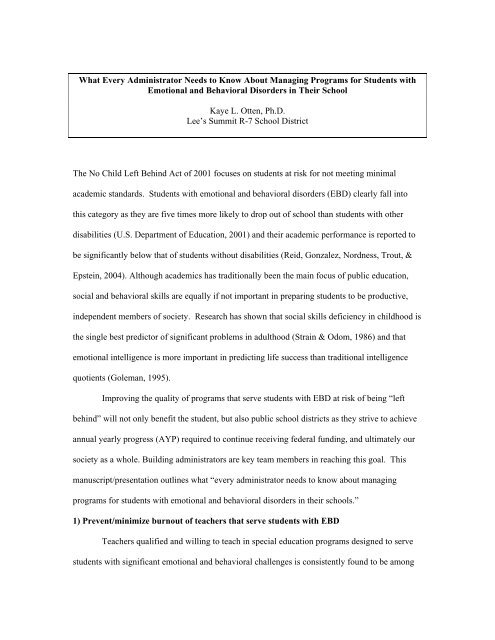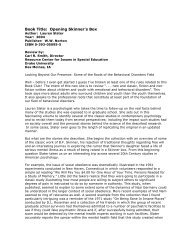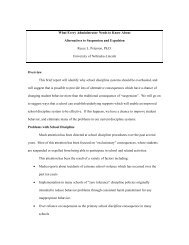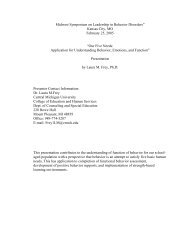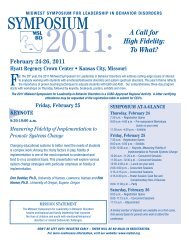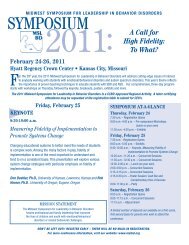Otten 10-6-06.pdf - MSLBD
Otten 10-6-06.pdf - MSLBD
Otten 10-6-06.pdf - MSLBD
You also want an ePaper? Increase the reach of your titles
YUMPU automatically turns print PDFs into web optimized ePapers that Google loves.
What Every Administrator Needs to Know About Managing Programs for Students with<br />
Emotional and Behavioral Disorders in Their School<br />
Kaye L. <strong>Otten</strong>, Ph.D.<br />
Lee’s Summit R-7 School District<br />
The No Child Left Behind Act of 2001 focuses on students at risk for not meeting minimal<br />
academic standards. Students with emotional and behavioral disorders (EBD) clearly fall into<br />
this category as they are five times more likely to drop out of school than students with other<br />
disabilities (U.S. Department of Education, 2001) and their academic performance is reported to<br />
be significantly below that of students without disabilities (Reid, Gonzalez, Nordness, Trout, &<br />
Epstein, 2004). Although academics has traditionally been the main focus of public education,<br />
social and behavioral skills are equally if not important in preparing students to be productive,<br />
independent members of society. Research has shown that social skills deficiency in childhood is<br />
the single best predictor of significant problems in adulthood (Strain & Odom, 1986) and that<br />
emotional intelligence is more important in predicting life success than traditional intelligence<br />
quotients (Goleman, 1995).<br />
Improving the quality of programs that serve students with EBD at risk of being “left<br />
behind” will not only benefit the student, but also public school districts as they strive to achieve<br />
annual yearly progress (AYP) required to continue receiving federal funding, and ultimately our<br />
society as a whole. Building administrators are key team members in reaching this goal. This<br />
manuscript/presentation outlines what “every administrator needs to know about managing<br />
programs for students with emotional and behavioral disorders in their schools.”<br />
1) Prevent/minimize burnout of teachers that serve students with EBD<br />
Teachers qualified and willing to teach in special education programs designed to serve<br />
students with significant emotional and behavioral challenges is consistently found to be among
the highest ranked needs areas. There is little competition for these positions resulting in a<br />
greater percentage of teachers that fill them being uncertified and/or having an alternative<br />
certificate and having significantly fewer years of teaching experience as compared to those that<br />
serve other special education populations (Billingsley, Fall, & Williams, 2006). This results in<br />
the most difficult students to manage being taught by the least prepared to manage them, partially<br />
explaining the high rates of stress and burn out.<br />
There are many things that building administrators can and should do to attempt to<br />
alleviate the problem of EBD teacher burnout. First, it is important that the teachers,<br />
paraprofessionals and students in these programs feel like a welcome part of the school<br />
community. Inclusion in schoolwide activities (e.g. special day parties, birthday celebrations,<br />
etc.) and daily visits from building administrators and other building support staff can help<br />
accomplish this. Building administrators taking the time to personally get to know students<br />
served in these programs and their families in addition in regularly meeting with the EBD<br />
program staff can also help meet this goal.<br />
Second, teachers in these programs are often very isolated from others that share their<br />
same job position as there is usually only a few in each school district. In order for them to<br />
develop the skills they need and form valuable collaborative partnerships with other educators of<br />
students with EBD, it is essential that they be allowed to pursue professional development<br />
activities in their area of specialty. This may be less convenient and more costly for school<br />
districts than the professional development needs of general and other types of special educators<br />
and needs to be supported by building administrators.<br />
Third, many of programs for students with EBD have several grade levels in one<br />
classroom, which can make scheduling a logistical nightmare. In addition, teachers report that<br />
they are often having to write their own curriculum, do not have teacher’s manuals and other<br />
basic materials for all of the grade levels they teach, and work during their lunch and plan time in<br />
order to provide adequate supervision and instruction to their diverse students. It is essential that
teachers are provided with adequate materials and curriculum, including a social skills<br />
curriculum. In order to adequately plan for a variety of grade and skills levels, they also need<br />
adequate planning time in addition to regular breaks and an uninterrupted lunch time.<br />
2) Require the program to embrace the philosophy of positive behavior supports and<br />
interventions<br />
The Individuals with Disabilities Education Act (IDEA) creates a presumption in favor of<br />
positive behavior supports and interventions, sometimes referred to as PBS or PBIS. Although<br />
the federal government does not specifically define PBS, a multi-university consortium that<br />
provides technical assistance related to PBS does. According to the Office of Special Education<br />
Programs (1999), positive behavior supports: 1) are behaviorally based, 2) enhance the capacity<br />
of schools, families, and communities to provide effective environments, 3) are based on<br />
research-validated practices, 4) improve lifestyle results, 5) make problem behavior less effective,<br />
efficient, and relevant, and 6) make desired behavior more functional. The focus of positive<br />
behavior supports is on prevention, early intervention, skill building, and positive reinforcement<br />
of appropriate behavior rather than relying on traditional reactive and punitive contingencies such<br />
as time out, office referrals, suspension, and expulsion.<br />
3) Understand the functional behavioral assessment (FBA)/behavior intervention plan (BIP)<br />
process<br />
A functional behavioral assessment is a process for understanding problem behavior and<br />
factors that contribute to its occurrence and maintenance. The main purpose is to guide the<br />
development of effective, efficient, and relevant behavior intervention plans (Sugai, Lewis-<br />
Palmer, & Hagan-Burke, 2000). IDEA requires that anytime behavior negatively impacts<br />
learning, a functional behavioral assessment must be conducted resulting in a behavioral<br />
intervention plan that is included in the student’s individual education plan.
The intensity and complexity of individual functional behavioral assessment activities<br />
will vary as not all problem behaviors and situations require the same level of assessment (Sugai,<br />
Lewis-Palmer, & Hagan-Burke, 2000). At the preliminary level, the objective is to “collect the<br />
smallest amount of useful information that results in summary statements to which key<br />
individuals can agree and have high confidence about their accuracy” (Sugai, Lewis-Palmer, &<br />
Hagan-Burke, 2000, p. 152). There is some disagreement in the field regarding what are the<br />
essential components of an adequate functional behavioral assessment (Scott, Meers, & Nelson,<br />
2000). A review of current case law indicates that the behavior intervention plan must: 1) be<br />
based on assessment data, 2) be individualized, 3) include positive behavior support, and 4) be<br />
implemented as planned and effectively monitored (Etscheidt, 2006). Based on a review of a<br />
number of articles and personal experience, this author identifies the essential components of<br />
functional behavioral assessments and behavior intervention plans as follows:<br />
Essential Components of a Functional Behavioral Assessment<br />
• Assessment data sources-both direct and indirect<br />
• Students’ strengths and interests<br />
• Problem behavior defined in observable terms<br />
• Setting events or conditions that exaggerate the likelihood of the defined problem behaviors<br />
• Triggering antecedents or events that happen immediately before the problem behavior<br />
• Maintaining consequences or events that happen immediately after the problem behavior that<br />
reinforce and maintain it<br />
• The hypothesized function of the behavior<br />
• Confirmation of the hypothesis<br />
Essential Components of a Behavior Intervention Plan<br />
• Desired replacement behavior that serves the same function as the problem behavior<br />
• Direct instruction of this replacement behavior<br />
• Manipulation of setting and antecedent events to prevent the problem behavior from occurring
• Positive consequences for the desired replacement behavior<br />
• Logical undesirable consequences for the problem behavior<br />
• Crisis intervention plan if needed<br />
• Plan for monitoring effectiveness based on ongoing assessment data<br />
4) Require the program to focus equally on behavior and academic interventions<br />
The academic performance of students with EBD is significantly below that of students<br />
without disabilities (Reid, Gonzalez, Nordness, Trout, & Epstein, 2004) and social-behavioral<br />
difficulties co-occur with language difficulties 40-80% of the time (Benner, Nelson, & Epstein,<br />
2002). Any experienced practitioner of these students will testify that frustration with academic<br />
tasks is often an antecedent to problem behavior. In addition, there is some research that supports<br />
the idea that academic interventions may have the collateral effect of reducing problem behavior<br />
(Coie & Krehbiel, 1984; DuPaul, Ervin, Hook, & McGoey, 1998). Considering these facts, a<br />
strong argument can be made that the effectiveness of educational programs for students with<br />
EBD can be strengthened through strong academic interventions in addition to program<br />
components that support healthy emotional and social/behavioral skills development.<br />
6) Consider alternatives to out of school suspension<br />
Many public school administrators argue that they can not individualize discipline<br />
practices for students with emotional and behavioral disorders due to safe schools legislation.<br />
However, safe school laws do not override the IDEA. Discipline plans can and should be<br />
individualized based on the findings of functional behavior assessments and specified in<br />
individualized behavioral interventions plans when appropriate. It is imperative to realize that<br />
sometimes suspension can actually reinforce the behavior (e.g. the student is aggressive because<br />
he/she wants to be sent home to escape the demands of the school environment) and may cause it<br />
to increase. Working with the educational team to generate alternative consequences that are<br />
meaningful while ensuring the safety of all may include but is not limited to restricted privileges,
involvement of school security officers, and/or direct instruction concerning the real life<br />
consequences of unsafe behavior in the adult world.<br />
7) Invest and participate in crisis prevention and intervention training<br />
All public school personnel should be trained in early prevention and de-escalation of<br />
aggression. There are several programs available nationally designed for this purpose (Table 1).<br />
Although this can be an investment of time and finances initially, it may significantly reduce<br />
and/or prevent future safety and legal problems and the need for physical management. Although<br />
ideally crisis will be prevented or deescalated by trained individuals, there is never a guarantee<br />
that aggressive behavior will not occur. Therefore, staff working directly with students with EBD<br />
who are at high risk of exposure to aggressive and violent behavior should be trained in ethical,<br />
nonviolent physical management used only as a last resort to ensure the care, welfare, safety and<br />
security of all individuals.<br />
Table 1<br />
Crisis Prevention and Intervention Programs<br />
Program<br />
Nonviolent Crisis Intervention<br />
The Mandt System<br />
Therapeutic Crisis Intervention (TCI)<br />
Contact Information<br />
Crisis Prevention Institute, Inc. (CPI)<br />
3315-K North 124 th Street<br />
Brookfield, WI 53005<br />
800-558-8976<br />
http://wwwcrisisprevention.com<br />
info@crisisprevention.com<br />
David Mandt & Associates<br />
P.O. Box 831790<br />
Richardson, TX 75083-1790<br />
972-495-0755<br />
http://www.mandtsystem.com/<br />
comment@mandtsystem.com<br />
Residential Child Care Project<br />
Family Life Development Center<br />
Beebe Hall<br />
Cornell University, Ithaca, NY 14853<br />
607-254-52<strong>10</strong><br />
http://rccp.cornell.edu<br />
eas20@cornell.edu<br />
8) Know the law and best practice concerning controversial interventions such as seclusion<br />
time out
The 1998, the Hartford Courant ran a series of articles on patient injury and death due to<br />
medication, restraint, and seclusion combinations (Weiss, Megan, & Altimari, 1998). This<br />
increased public awareness and sparked a national movement toward the drastic reduction if not<br />
zero tolerance of restraint and seclusion. In May 2003, the Administrator of Substance Abuse and<br />
Mental Health Services issued a national call to reduce and eventually eliminate restraint and<br />
seclusion procedures and in April 2004 the Alliance to Prevent Restraint, Aversive Interventions,<br />
and Seclusion was founded. These and other events have resulted in an increase in due process<br />
cased filed against school district involving seclusion timeout issues nationwide.<br />
It is important to note that not one incident reported in the Hartford Courant occurred in a<br />
public school setting or involved the used of seclusion time out exclusively. An argument can be<br />
made that the proper use of seclusion timeout can reduce the need for physical management and<br />
more restrictive non-public contractual placements, where seclusion timeout and physical<br />
management are commonly used. It is imperative that public schools are fully aware of their<br />
ethical, moral, and legal responsibilities surrounding the use of these controversial interventions<br />
and take every action to ensure that the use of these procedures are closely monitored and reduced<br />
to the greatest extent possible, with the ultimate goal of elimination.<br />
As previously discussed in this document, every student with EBD’s individual education<br />
plan must have a current behavioral intervention plan based on functional behavioral assessment<br />
that includes direct instruction of replacement behavior and other positive behavior supports (e.g.<br />
visual supports, token economies, etc.) and is monitored by a data collection system. This data<br />
must be reviewed regularly and the behavior intervention plan must be modified if progress is not<br />
being made. Seclusion time out or physical management should never be used for simple noncompliance.<br />
Other positive behavior support strategies and/or related logical consequences that<br />
are less restrictive should be available. Students should be directly taught how to transport<br />
themselves to seclusion timeout appropriately and highly reinforced for doing so. This behavior<br />
should be reviewed and practiced often when the student is in a calm, thinking state. Students in
seclusion timeout must be continuously monitored and should review appropriate replacement<br />
behaviors and the connection between their behavior choices and national/logical consequences<br />
such as seclusion timeout immediately after its occurrence. Detailed documentation regarding<br />
each occurrence of seclusion timeout should be kept and reviewed regularly to guide decision<br />
making.<br />
9) Commit to providing the least restrictive environment<br />
Providing the least restrictive environment means that there is a full continuum of<br />
placement options available to students with EBD including the regular classroom, the regular<br />
classroom with consultation, the regular classroom with supplementary instruction and services<br />
and a separate classroom program with clear guidelines for reentry into the regular classroom<br />
environment. It is important that all school personnel realize that diagnosis does not drive<br />
placement in addition to being accountable for providing the needed modifications and<br />
accommodations for these students in all academic and non-academic school environments.<br />
<strong>10</strong>) Base decisions concerning more restrictive placement on adequate data<br />
For profit alternative schools that serve students with significant emotional and<br />
behavioral challenges are a multi-billion-dollar industry with tuition running as high as $40,000<br />
to $60,000 annually (Council for Exceptional Children, 1998). Simpson (1998) states that these<br />
settings “offer few opportunities for students to return to more normalized settings when their<br />
progress warrants” and “have the potential to do significant harm” (p. 288). Considering this<br />
huge expense and fact that these placement completing exclude students from their general<br />
education peers, the decision to negotiate contracts with these agencies is a very serious one that<br />
needs to be based on meaningful data collected over a significant period of time. It is imperative<br />
to consider if the needed services could have been added to the public school program with the<br />
financial resources spent on contractual placement and to remember that students in private
contractual placements remain the public school district’s legal, ethical, and financial<br />
responsibility.<br />
References<br />
Benner, G.J., Nelson, J.R., & Epstein, M.H. (2002). Language skills of children with<br />
EBD: A literature review. Journal of Emotional and Behavioral Disorders, <strong>10</strong>, 43-<br />
59.<br />
Billingsley, B.S., Fall, A., & Williams, T.O. (2006). Who is teaching students with<br />
emotional and behavioral disorders?: A profile and comparison to other special<br />
educators. Behavioral Disorders, 31(3), 252-264.<br />
Coie, J., & Krehbiel, G. (1984). Effects of academic tutoring on the social status of lowachieving,<br />
socially-rejected children. Child Development, 55, 1465-1478.<br />
Council for Exceptional Children (1998). Alternative schools: Hope or heartache.<br />
Today, 5(2).<br />
DuPaul, G.J., Ervin, R.A., Hook, C.L., & McGoey, K.E. (1998). Peer tutoring for<br />
children with attention deficit hyperactivity disorder: Effects on classroom behavior<br />
and academic performance. Journal of Applied Behavior Analysis, 31, 595-592.<br />
Etscheidt, S. (2006). Behavior intervention plans: pedagogical and legal analysis of<br />
issues. Behavioral Disorders, 31(2), 223-243.<br />
Goleman, D.L. (1995). Emotional intelligence. New York: Bantam.<br />
Reid, R., Gonzalez, J.E., Nordness, P.D., Trout, A., & Epstein, M.H. (2004). A meta-analysis of<br />
the academic status of students with emotional/behavioral disturbance. The Journal of<br />
Special Education, 38, 130-144.<br />
Scott, T.M., Meers, D.T., & Nelson, C.M. (2000). Toward a consensus of functional behavioral<br />
assessment for students with mild disabilities in public school contexts: A national<br />
survey. Education and Treatment of Children, 23(3), 265-285.<br />
Simpson, R.L. (1999). Children and youth with severe behavioral problems: Entitlement,<br />
empiricism and ethics. Behavioral Disorders, 23(3), 184-192.<br />
Strain, P.S., & Odom, S.L. (1986). Peer social initiations: Effective intervention for social skills<br />
development of exceptional children. Exceptional Children, 52, 543-551.<br />
Sugai, G., Horner, R.H., Dunlap, G., Hieneman, M., Lewis, T.J., Nelson, C.M., Scott, T.,<br />
Liaupsin, C., Sailor, W., Turnbull, A. P., Turnbull, H.R., Wickham, D., Ruef, M., &<br />
Wilcox, B. L. (1999). Applying positive behavioral support and functional behavioral<br />
assessment in schools. Eugene: University of Oregon, OSEP Center on Positive<br />
Behavioral Interventions and Supports.
Sugai, G., Lewis-Palmer, T., & Hagan-Burke, S. (1999-2000). Overview of the functional<br />
behavioral assessment process. Exceptionality, 8(3), 149-160.<br />
U.S. Department of Education (2001). Twenty-third annual report to Congress on the<br />
implementation of the Individuals with Disabilities Education Act. Washington, DC:<br />
Author.<br />
Weiss, E., Megan, K., Bline, D.F., & Altimari, D. (1998, October 11-15). Deadly restraint<br />
[Investigative report series]. Hartford Courant. Retrieved July 29, 2003 from<br />
http://courant.ctnow.com/projects/restraint/data.stm.


